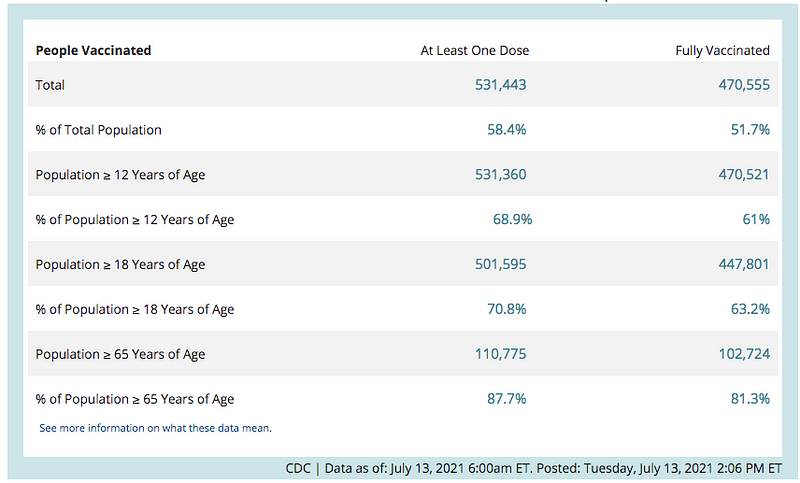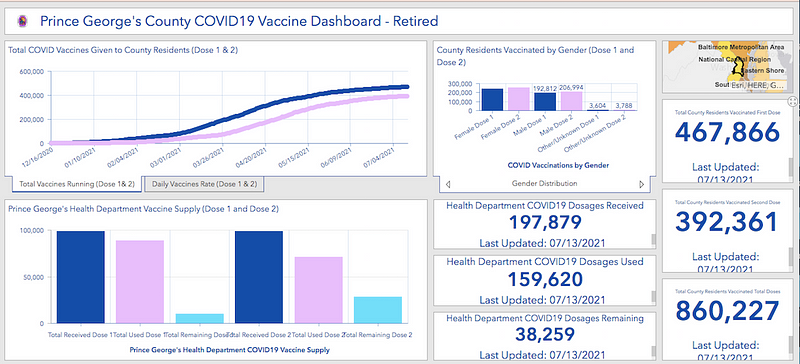P.G. County’s Unvaccinated And Partially Vaccinated Are At Higher Risk of Contracting The Delta.
Newsletter Sign Up
〰️
Newsletter Sign Up 〰️
“If you want to protect the surrounding people or help to break the chain of transmission, then the second dose [or completing your vaccination] helps us all to get out of this trouble.”
Prince George’s County, with the resources that have been allocated by the state, has continued to reach out to its residents to get vaccinated. County Executive Angela Alsobrooks has promoted getting younger people vaccinated via social media. Health officials have aggressively tried to vaccinate its preteen population. In July, they will host four scheduled events to vaccinate people in the county, targeting young people. For the most part, county officials have successfully vaccinated the elderly community, which is at 80 percent fully vaccinated. Though the state has closed the county’s mass vaccination sites, people are still able to get vaccinated at pop-up clinics, and at CVS. The county has encouraged barbers and hairstylists to encourage Black people as well as other people of color to get vaccinated. The county has done heavy outreach within Black Christian communities, and activists have also attempted to get residents vaccinated.
Despite these efforts, PG County, like the rest of Maryland, has struggled to fully vaccinate its residents. Some who have been vaccinated have only been partially vaccinated. With Covid-19 cases on the rise again, people who are unvaccinated along with those who are partially vaccinated are at higher risk of catching the new delta variant (compared with those who have been fully vaccinated), and possibly spreading it to others.
“If you’ve only gotten one dose, you’re probably not going to end up in the hospital or dying from COVID-19, so the first dose does you a lot of good,” explained Dr. Stuart Ray, vice chair of medicine for data integrity and analytics at Johns Hopkins University. “But it doesn’t do that much good for the surrounding people. If you want to protect the surrounding people or help to break the chain of transmission, then the second dose [or completing your vaccination] helps us all to get out of this trouble.”
Ray said, citing data from the United Kingdom around the Delta variant, persons who are fully vaccinated with two doses of the Pfizer or Moderna vaccine have a 90 percent efficacy rate against the variant. However, the vaccine is not meant to only protect the people who receive it, but also those around you.
Ray, who worked during the AIDS epidemic, admits that there isn’t a lot of data on people who have only had the first dose, but said the second dose boosts the first. The second dose of the vaccine “reinforces the cells that made a good response the first time.”
“When you get that second dose, your [immunity] stays up for a long time, at least for 8 months. But it does look like we will not need [a third] booster for a long time,” he said. “But the people who have only gotten one dose, those people will probably have decreasing immunity over time.”
According to the CDC, people should wait 2 to 3 weeks after getting their first shot of the Pfizer and Moderna vaccines. Ray said the first dose of the COVID-19 vaccine (from Pfizer and Moderna) starts to build a defense against Covid-19 about 2 to 3 weeks after first received. However, after those weeks have lapsed — the percentage of protection begins to decrease rapidly. People who are unvaccinated, and maybe prolonging their second shot outside the allotted time, are putting themselves at risk as well as children, and immunocompromised people. These people, Ray added, could help to teach the virus to get around the immune responses cultivated by the first dose.
Ray said he used to tell his HIV patients that if you get in a fight with Mike Tyson, a championship boxer, you need to knock him out. If you don’t, he said, “[Tyson] is going to learn your tricks.” Likewise, he said, “you don’t want HIV patients partially taking their medicines.”
This is similar in the case of COVID-19 vaccination.“If you give a partial response to the vaccine, one dose, it’s not worse than getting no vaccine at all, but it gives the COVID-19 virus a chance to see what a partial immune response looks like and maybe survive in the presence of that fight long enough to learn its tricks. We don’t want to just swing at the virus — we want to knock it down,” said Ray.
“Every chance we get to fully vaccinate someone and really build a wall against the infection, is one less person where the virus is going to mutate while it’s in them, and then change before it gets to the next person,” Ray explained.
Who Is Vaccinated In Prince George’s County?
P.G. County has 864,029 residents. Of those residents, 64 percent are Black, 20 percent are Latinx, 12 percent are White. Though COVID-19 cases were decreasing, they have begun to rise again. According to Maryland Department of Health’s data, the county has 86,073 confirmed cases, which surpasses all other counties in the state. The county has the third-highest Covid death total, 1563, Montgomery County and Baltimore are ahead. More women (45,097) than men (40,910) have contracted the virus. But more African American men (893) have died from the virus than women (670). In all, African Americans in the state have contracted the virus, died, and have been hospitalized more than any other ethnic group in the state. The next highest group is the Latinx community.

However, when it comes to the county’s internal vaccination data, it appears that there are some inconsistencies. The county’s first shot data, located on its website, is lower than the CDC’s. On the county’s COVID vaccination data website, it says: “All data is considered preliminary, as it is subject to change based on additional reporting.” On July 13, The P.G. County Health department tweeted the County Executive’s Vaccine Bulletin, which cited the CDC’s data, and not the county’s internal data, which have different numbers. Since posting, the CDC data shows, as of July 15, that 502,686 of 18–65-year-olds have received at least one shot, increasing the rate to 71 percent. There are, according to the same CDC data, 449,089 fully vaccinated people in P.G. County. This data could include the J&J vaccine, but the data doesn’t specify that. The CDC has stopped displaying this sort of data. The page that is supposed to show vaccination states in the states and counties now shows COVID-19 case data.

The P.G. County Health department’s data shows that only 475,208 residents have received their first shots. And 399,166 residents have received a second shot. The 2nd shot data point suggests that these are people who are fully vaccinated. This number is lower than the CDC’s fully vaccinated residents. P.G. County’s vaccination shot data combines the 1st shot data and second shot data for a total of 866,062 of total doses administered. The county’s health department data doesn’t show J&J shots given. However, Maryland’s coronavirus site shows that only 49 percent, not 71 percent, of the county’s residents have received their first shot. Additionally, only 43 percent of its population is fully vaccinated. Mysightly, a website that uses Maryland Coronavirus data, shows the same data. According to this data set, Howard County, 67 percent, and Montgomery County, 64 percent, are the only two counties that are nearing the milestone of vaccinating 70 percent of their population with the first dose. Both are majority white counties.
The Intersection is not sure why this discrepancy exists. We reached out to the P.G. County Health department asking to speak with someone about the difference in data. The representative said she would return our call, but has not yet. We also reached out to CVS media contacts. Maryland’s residents can go to CVS to get vaccinated, so we assume that they record that data. CVS has not returned our emails asking about vaccination data. Once people sign up for their first shots, they are immediately scheduled for their second. However, it is not known if people will follow through on their second shot. Also, there are still some people who are, unable to get vaccinated due to health problems.
There are several reasons why the county leads the state in COVID-19 cases. The county hasn’t built the medical infrastructure needed — in large part due to state funding — to accommodate its residents. P.G. County has high lead levels, and pollution caused by power plants, which contributes to residents’ underlying health conditions. Due to the county’s proximity to Washington, D.C., a lot of its residents work in the city. Furthermore, many P.G. County residents are grocery store workers, fast food, and Metro workers (bus and trains) and therefore have put their lives on the line to provide services to the region throughout the pandemic. They did so though they were in danger of contracting and spreading the virus. Even as the threat of the Delta variant spreads, and cases are on the rise, these DC, Virginia, and Maryland essential workers are still working.
Early when the state opened a vaccination site at the Prince George’s Sports and Learning Complex, residents from neighboring counties signed up to get vaccinated-clogging the online registration system. Due to this, some older P.G. County residents were not able to register to be vaccinated during their allotted time for vaccinations. Others had to wait to sign up. County Executive Angela Alsobrooks and health administrators decided to allocate vaccinations only to P.G. County residents. Healthcare workers’ lack of adequate care for Black residents can also contribute to vaccine hesitancy among some Black people in the county. In addition, misinformation about the vaccine may also contribute to Black people’s hesitancy to get fully vaccinated.
“I don’t think we can wait until things get bad to start vaccinating people,” he explained. “That is not how the vaccine works. You need to give it time to work.”
Maryland & Vaccines
Although Maryland ranks in the top 10 for vaccinating its citizens, like P.G. County, there are more partially vaccinated residents than fully vaccinated statewide.
In Maryland, at least 76 percent of residents have received one dose of the Pfizer and Moderna vaccines. Maryland has about 6,045,680 million residents. According to the Maryland Health Department, as well as Johns Hopkins, data show that the state has distributed 8,649,450, and administered 7,046,796. However, only 3,498,124 are fully vaccinated, which is 58 percent of the population. Partially vaccinated people in the state outpace those who are fully vaccinated, like in P.G. County.
In addition, this gap also glides along with racial categories. White people, in general, have received more vaccines than any other ethnic group in the state. White people are more partially vaccinated than Black people and any other ethnic group, and have received more of the J&J vaccination than Black people. In early June, The Intersection asked the Maryland Department of Health for the number of first doses distributed according to vaccine type. At that time, the state had administered 1,876,299 (Pfizer), 1,315,414 (Moderna), and 244,699 J&J. We inquired about these same numbers in late June. The health department replied with data that combined the first and second shots: 3,606,467 (Pfizer), 2,462,834 (Moderna), and 239,661 (J&J).
Heading into the summer, there was much celebration about the vaccine rollout, and those getting vaccinated. But as the summer continued, fewer people were getting vaccinated and the messaging of vaccination seemed to soften. In addition, in May when the US was still at the beginning of vaccinating its citizens, the CDC announced that people no longer needed to wear masks outside or inside. The states were free to implement this policy as they wanted. Maryland chose to go along with the CDC. In combination with all of this, multiple media outlets, while in the midst of a pandemic, declared that we were moving back to normal. Such announcements and decisions had ripple effects. The unvaccinated, some who did not wear masks even before the vaccine rolled out, now had ammunition to continue not wearing masks. People became confused as to conduct themselves. Vaccination rates have also decreased since May. Both the vaccinated, partially vaccinated, children (who can not yet get vaccinated) and the immunocompromised gathered privately and publicly. Bars and restaurants reopened. The Governor of Maryland Larry Hogan ended the State of Emergency at the beginning of July.
Overall COVID-19 cases, hospitalizations, and deaths were indeed low. But there were still thousands of unvaccinated and partially vaccinated people. And when Maryland became one of the top 10 states that vaccinated its people, its strong message, and reach into the counties, that everyone should get vaccinated seemed to become less important. The state has made sure to announce its efforts to provide an incentive to adults and college students who get vaccinated. This may encourage some to get vaccinated. However, continued information about the vaccines, their efficacy, and how they came into being should be a continued message.
I talked to Dr. Ray early in July when the Delta variant was just starting to spread throughout the country. However, at that time, new COVID-19 cases were slowly increasing, but relatively still low. Ray said during that time, not a lot of people were contracting the virus or dying, and hospitalizations were still low. This potentially made people feel like things were moving back to normal, and complacency set in.
“It is very hard to hold restrictions when people aren’t seeing a lot of sicknesses. So I can understand why the governor and the mayor of Baltimore are feeling some pressure to relax restrictions because when you look around it’s not a tragedy right now,” said Ray.
There needs to be better messaging. Ray said state and health officials should explain to Maryland residents why restrictions were relaxed. It was done so, Ray said, because there were low COVID-19 positivity rates during the summer, and hospitalizations and deaths were lower. Such an explanation informs the community about how the virus works, why the local government has chosen to relax restrictions and the impact of vaccinations on the virus.
But Ray said it should also be communicated that we are not out of the clear. That COVID-19, as we see now, is still around. The Delta variant spreads more rapidly and appears to be deadlier. Ray is worried about the fall. In the fall of 2020 — Covid -19 cases spiked. The Delta variant could also spike during the fall or another kind of variant. Ray said now is the time for people to take advantage of getting vaccinated.
“I don’t think we can wait until things get bad to start vaccinating people,” he explained. “That is not how the vaccine works. You need to give it time to work.”
Screenshot 1: Here is a screenshot of the CDC data time-stamped for July 13. Photo by Delonte Harrod
Screenshot 2: Here is a screenshot of the P.G. County’s Covid-19 internal data taken July 13. Photo by Delonte Harrod

